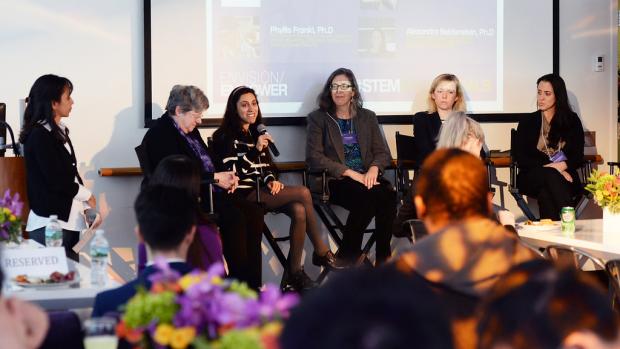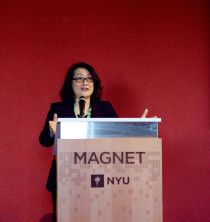Envisioning Gender Equality and Empowering STEM Women

Look around almost any laboratory or technology company, and the statistics are borne out. Although women comprise 50% of the overall labor force, only a quarter of the people working in STEM fields are female.
In celebration of Women’s History Month in March—and as part of the year-round efforts the entire Tandon community makes to address that situation—Associate Dean of Student Affairs Anita Farrington and her staff produced the 2016 Women in STEM Summit, a two-day event jam-packed with speakers, workshops, panels, and more.
The theme of the Summit was “Envision and Empower,” and Farrington opened the proceedings with a rousing call to arms. “Why not have a STEM workforce that reflects the demographics of our country?” she asked. “We are justifiably impatient and we envision so much more.” She continued, “At Tandon, we are steadfastly committed to increasing the number of women in our programs, and while we have certainly enjoyed seeing polls that have referred to us as one of the nation’s most ‘female-friendly’ schools, we envision even more.”
Pointing out that for the past few years, entering classes have contained increasing numbers of women and that the trend is anticipated to continue next fall, Farrington concluded, “Without a doubt the needle is moving . . . so I implore you to truly envision and, ultimately, to be truly empowered to pursue your dreams.”
Xi Tang Zhao, a sophomore who is studying electrical engineering, was just one of several men in the audience, thanks in some part to the Office of Student Affairs push to include them. “I support my female classmates and colleagues because we all benefit from learning and working together,” he asserted. “Gender diversity in STEM is far from just a women’s issue.” He particularly enjoyed participating in the roundtable discussions that followed Farrington’s opening and featured such industry leaders as Britt Hykal, a recruiting coordinator at Google, and Georgia Forbes, an executive director of information security at Goldman Sachs. “A group of male engineers might never think to sit down and discuss an issue like work-life balance, but those things are important to all of us,” he said. “It just reinforces the idea that women’s concerns are men’s concerns as well.”
That leitmotif was heard repeatedly throughout the event, which even concluded with a panel discussion between Department Head and Professor of Computer Science and Engineering Nasir Memon and AIG Talent Management Analyst Nathan Rubin entitled “How Men Can Help.” Moderated by student leader Alexander Lawson, the conversation ranged from the importance of maintaining a civil, welcoming atmosphere devoid of demeaning terminology or sexist humor to one common-sense method of obtaining gender balance in the workplace: simply hire more women.

Minerva Tantoco, Chief Technology Officer for the City of New York
Before then, however, attendees were treated to a keynote speech by Minerva Tantoco, the first-ever Chief Technology Officer (CTO) for the City of New York, who informed the attendees that a significant percentage of the venture-capital-funded start-ups in the city had been founded by women and quipped to them, “Woman techies are a thing now! You are in the right place at the right time.” She concluded, “Technology is the future of work, and you are the future of technology.”
Attendees also heard a talk by alum Patricia McLaughlin, who described being one of only two female students in the aerospace engineering program during the early 1970s. “I had come from an all-girls’ Catholic school where I had taken home economics as part of a not-very-rigorous curriculum,” she said, “and I walked into a group of male engineering students who were whipping out expensive slide rules.” Intimidating mathematical equipment aside, McLaughlin’s classmates understood the importance of supporting a fellow aspiring engineer. “They helped me catch up,” she recalled. “They really wanted me to succeed. They taught me that it wasn’t a sign of weakness to ask for help if I needed it and that while it’s good to focus on climbing, you shouldn’t squash anyone else while you do so.”
If there was any single takeaway from the Summit it was that when everyone—male or female—works towards a goal like gender equality together, that goal gets significantly more achievable.




